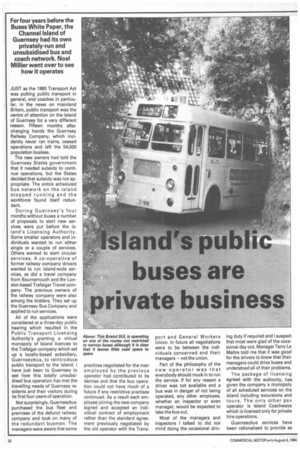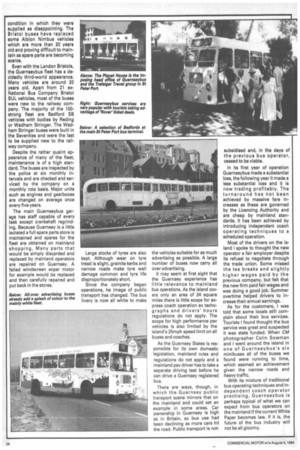no s public buses are private business
Page 24

Page 25

Page 26

If you've noticed an error in this article please click here to report it so we can fix it.
JUST as the 1980 Transport Act was putting public transport in general, and coaches in particular, in the news on mainland Britain, public transport was the centre of attention on the Island of Guernsey for a very different reason. Fifteen months after changing hands the Guernsey Railway Company, which incidently never ran trains, ceased operations and left the 54,000 population busless.
The new owners had told the Guernsey States government that it needed subsidy to continue operations, but the States decided that subsidy was not appropriate. The entire scheduled bus network on the island stopped running and the workforce found itself redundant.
During Guernsey's four months without buses a number of proposals to start new services were put before the island's Licensing Authority. Some smaller operators and individuals wanted to run either single or a couple of services. Others wanted to start circular services. A co-operative of former railway company drivers wanted to run island-wide services, as did a travel company from Bournemouth and the London-based Trafalgar Travel company. The previous owners of the railway company were also among the bidders. They set up the Guernsey Bus Company and applied to run services.
All of the applications were considered at a three-day public hearing which resulted in the Public Transport Licensing Authority's granting a virtual monopoly of Island licences to the Trafalgar company which set up a locally-based subsidiary, Guernseybus, to reintroduce public transport to the island. I have just been to Guernsey to see how this totally unsubsidised bus operation has met the travelling needs of Guernsey residents and their visitors during its first four years of operation.
Not surprisingly, Guernseybus purchased the bus fleet and premises of the defunct railway company and took on many of the redundant busmen. The managers were aware that some practices negotiated for the men employed by the previous operator had contributed to its demise and that the bus operation could not have much of a future if any restrictive practises continued. As a result each employee joining the new company signed and accepted an individual contract of employment rather than the standard agreement previously negotiated by the old operator with the Trans port and General Workers Union. In future all negotiations were to be between the individuals concerned and their managers — not the union.
Part of the philosophy of the new operator was that everybody should muck in to run the service. If for any reason a driver was not available and a bus was in danger of not being operated, any other employee, whether an inspector or even manager, would be expected to take the bus out.
Most of the managers and inspectors I talked to did not mind doing the occasional driv ing duty if required and I suspect that most were glad of the occasional day out. Manager Terry Le Maitre told me that it was good for the drivers to know that their managers could drive buses and understood all of their problems.
The package of licensing agreed with the authority, has given the company a monopoly of all scheduled services on the island including excursions and tours. The only other psv operator is Island Coachways which is licensed only for private hire operations.
Guernseybus services have been rationalised to provide as comprehensive coverage of the island as possible. Like the whole island economy, Guernseybus depends on summer tourism to make its money. Its obligation to the licence also requires that it operates all-year round services so it inevitably cross-subsidises from the summer to the winter.
To make the most of its summer operation Guernseybus supplements its scheduled services with a full excursion tour programme as well as ferry transfer operations. It also sells one, two, five and seven-day bus rover tickets giving unlimited travel on all scheduled services.
Although Guernseybus is a member of the Trafalgar Travel group, and its head office at the Piquet House at St Peter Port is also a Trafalgar Travel office, it is operated as a separate entity under managing director Barrie Spears.
When the company won its licence application one of its first problems was to obtain a fleet of around 100 vehicles. In the event it purchased the existing fleet and depots of the former railway company, but as many in the fleet were getting on in years, it was obvious that some newer buses and coaches were required.
Getting buses for Guernseybus is not as simple as it may seem. First, the new company could not justify buying brand new buses initially, and, secondly, no bus over 7ft 61n wide can be put into service on the island. A number of routes have to be operated by even narrower buses. These vehicles are marked with a large letter A on the front and rear to make certain the company does not use wider buses on restricted roads.
To update the fleet Guernseybus has bought 12 ex-London Transport Bristol LH single deckers which were built between 1976 and 1977. These buses were in theory built to a width of 7ft 6in.
The first was inspected by the island Police service and after careful measuring certified as being the stipulated width and fit for service. But as additional buses were delivered and measured it became apparent that some were not.
Some were over width by as much as an inch, others by around a quarter of an inch. As the authorities refused to allow any of the over-width buses to be certified the company had to make 'adjustments' to the bodies before they were resubmitted.
Just what the adjustments were, remains a trade secret, but at the time of my visit 10 of the buses were in service.
The LH buses are proving popular with passengers as they have easier entrance steps than some of the older vehicles. They are also popular with the drivers as they are the first on the island to have power-assisted steering, and semi-automatic transmissions. The bad news is that they are far less economical than the older, less sophisticated buses in the fleet.
The ex-London buses are proving suited to the Guernsey conditions although engineer Michael Le Cras described the condition In which they were supplied as disappointing, The Bristol buses have replaced some Albion Nimbus vehicles which are more than 20 years old and proving difficult to main. tam as spare parts are becoming scarce.
Even with the London Bristol., the Guernseybus fleet has a decidedly third-world appearance. Many vehicles are around 20 years old. Apart from 21 exNational Bus Company Bristol SUL vehicles, most of the buses were new to the railway company. The majority of the 100strong fleet are Bedford SB vehicles with bodies by Reding or Wadham Stringer. The Wadham Stringer buses were built in the Seventies and were the last to be supplied new to the railway cornpany.
Despite the rather quaint appearance of many of the fleet, maintenance is of a high standard. The buses are inspected by the police at six monthly intervals and are checked and serviced by the company on a monthly rota basis. Major units such as engines and gearboxes are changed on average once every five years.
The main Guernseybus garage has staff capable of every task except crankshaft regrinding. Because Guernsey is a little isolated a full spare parts store is maintained and spares for the fleet are obtained on mainland shopping. Many parts that would be simply discarded and replaced by mainland operators are repaired on Guernsey. A failed windscreen wiper motor for example would be replaced and then carefully repaired and put back in the stores. Large stocks of tyres are also kept. Although wear on tyre tread is slight, grainite kerbs and narrow roads make tyre wall damage common and tyre life disproportionately short.
Since the company began operations, he image of public transport has changed. The bus livery is now all white to make the vehicles suitable for as much advertising as possible. A large number of buses now carry all over advertising, It may seem at first sight that the Guernsey experience has little relevance to mainland bus operations. As the island covers only an area of 24 square miles there is little scope for express coach operation so tachographs and drivers' hours regulations do not apply. The scope for high performance psv vehicles is also limited by the island's 25mph speed limit on all buses and coaches.
As the Guernsey States is responsible for its own domestic legislation, mainland rules and regulations do not apply and a mainland psv driver has to take a separate driving test before he can drive a Guernsey registered bus.
There are ways, though, in which the Guernsey public transport scene mirrors that on the mainland and could set an example in some areas. Car ownership in Guernsey is high as in Britain, so bus use had been declining as more cars hit the road. Public transport is not
In its first year of operation Guernseybus made a substantial loss, the following year it made a less substantial loss and it is now trading profitably. The turnaround has not been achieved by massive fare increases as these are governed by the Licencing Authority and are cheap by mainland standards. It has been achieved by introducing independent coach operating techniques to a scheduled operation.
Most of the drivers on the island I spoke to thought the new operator a fair employer despite its refusal to negotiate through the trade union. Some missed the tea breaks and slightly higher wages paid by the previous company, but felt that the new firm paid fair wages and was doing a good job. Summer overtime helped drivers to increase their annual earnings.
As for the customers, I was told that some locals still complain about their bus services. Tourists I found thought the bus service was great and suspected it was state funded. When CM photographer Colin Sowman and I went around the island in one of Guernseybus's six minibuses all of the buses we found were running to time, which seemed an achievement given the narrow roads and heavy traffic.
With its mixture of traditional bus operating techniques and independent coach operator practising, Guernseybus is perhaps typical of what we can expect from bus operators on the mainland if the current White Paper becomes law. If it is, the future of the bus industry will not be all gloomy.
























































































